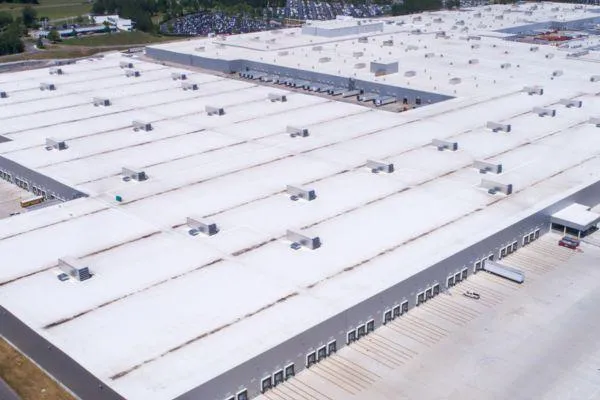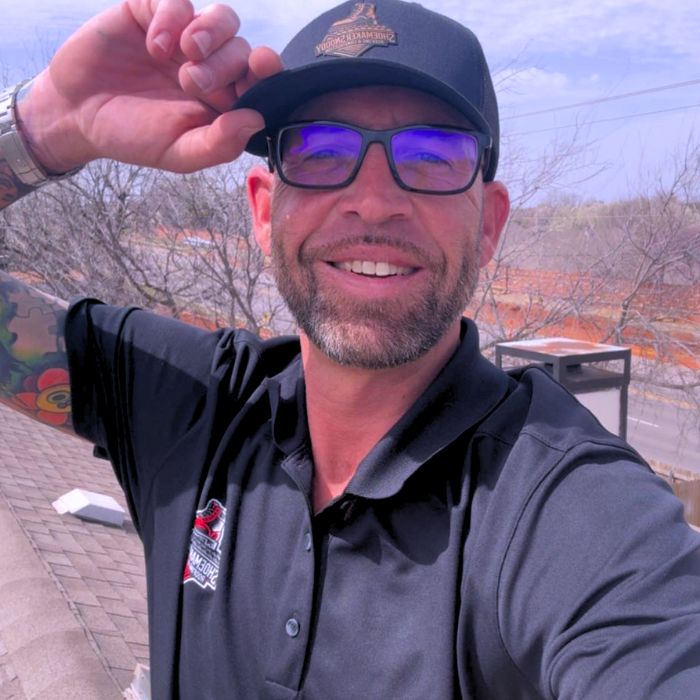
What Is TPO Roofing? Complete Guide to Benefits, Costs, and Installation in Oklahoma & Texas
TPO roofing stands for Thermoplastic Polyolefin, a single-ply, reflective, and energy-efficient roofing membrane that’s become a top choice for commercial and residential flat roofs, especially in hot, storm-prone regions like Oklahoma and Texas. It’s affordable, lightweight, resists UV damage, and helps cut cooling costs. At Shoemaker Roofing, we’ve installed TPO on everything from warehouses in Dallas to office buildings in Oklahoma City because it handles intense sun, hail, and wind beautifully, all while keeping energy bills down.
What is a TPO Roof and Why Are Roofers Talking About It?
A TPO roof uses a single-ply roofing membrane called Thermoplastic Polyolefin. It’s a flexible, durable, heat-weldable material that has quickly become a star in modern roof systems. TPO is one of the most popular choices today, especially for commercial roofing systems, but TPO is also used on residential low-slope roofs.
Why the buzz? First, the TPO roofing membrane is white, so it reflects UV rays and heat, lowering cooling costs. Second, it’s lightweight, strong, and free of plasticizers like PVC, making it more environmentally friendly. Third, it typically costs less per square foot than PVC while delivering great TPO performance.
Roofers and contractors often highlight that it’s easy to install, thanks to wide sheets of TPO that can be mechanically fastened or adhered to the roof deck. Plus, the hot-air welded seams create a strong, watertight bond that resists wind uplift and leaks better than older adhesive-only systems.
In short: it’s a versatile, cost-effective choice for anyone looking to update an existing roof or build a new commercial facility.
How Does a TPO Roofing Membrane Work?
Think of the TPO membrane as a shield: it covers the entire roof to protect it from water, UV damage, and heat. Made from a blend of polypropylene and ethylene propylene rubber, it creates a single-ply membrane that stays flexible yet strong.
Each sheet of tpo roofing material includes:
A top ply layer for UV and weather resistance.
A scrim (reinforced fabric) for strength and puncture resistance.
A base ply layer to adhere or fasten to roof insulation.
Contractors use hot-air welders to join the seams between sheets, which creates a watertight seal. This heat welding is a big reason why TPO outperforms many older roofing systems on the market.
And here’s why it matters: in places like Oklahoma and Texas, where sun, hail, and storms are frequent, a properly installed TPO roofing membrane can extend your roof’s life while cutting energy bills.
What Are the Advantages of a TPO Roofing?
The advantages of tpo roofing go beyond just price:
Energy efficiency: Its white reflective surface cuts down on energy costs by bouncing back UV rays and heat.
Durability: The tpo roof resists mold, tears, and chemicals better than many older membranes.
Ease of installation: Large rolls and lightweight material make it easy to install, saving labor costs.
Flexibility: TPO works well on new construction, retrofit over an existing roof, or on a commercial building with complex shapes.
Another big benefit? It doesn’t contain chlorine, so it’s more environmentally friendly and easier to recycle at the end of its life compared to PVC and other roofing products.
And remember: proper installation by experienced roofers is key to get these TPO benefits, a poorly installed membrane roof can lead to leaks, seam failure, and reduced lifespan.
TPO Roofing Material Costs: Is It Really Cost-Effective?
When people ask about tpo roofing costs, they usually mean both installation costs and long-term savings. TPO typically costs between $5 to $9 per square foot installed, which is lower than PVC and similar to EPDM.
Here’s why it can be more cost-effective:
Lower installation labor because sheets are wider and easy to install.
Lower cooling costs due to UV reflectivity.
Fewer repairs thanks to heat-welded seams.
Long term, you might save thousands in energy costs and avoid frequent patching common with older rubber roofing systems.
But remember, the final price depends on:
Roof size and complexity.
Whether you need new insulation or are tearing off the existing roof.
Choice of thickness (usually 45, 60, or 80 mil).
TPO vs EPDM vs PVC: Which Single-Ply Roof Membrane Wins?
Choosing between TPO, EPDM and PVC roofing depends on your needs.
TPO roofing system usually wins for energy savings in hot climates, while PVC is better for chemical-heavy environments (restaurants, factories). EPDM remains popular for very large, low-budget projects but absorbs heat.
How TPO Roofing is Installed
Many building owners hear "single-ply" membrane roofing and imagine a flimsy sheet glued on top, but installing a tpo roof is more technical and robust.
Step-by-step overview:
Remove or inspect the existing roof.
Install new roofing insulation for energy performance and smooth base.
Roll out the TPO membrane, overlapping seams.
Secure with fasteners (mechanically fastened) or adhesives (fully adhered).
Hot-air weld the seams so sheets fuse together.
Install edge metal, flashings, and seal penetrations.
Typical timeline:
Smaller residential flat roof: a few days.
Mid-size commercial building: a week or two.
Large warehouses: longer, but still faster than multi-ply or metal systems.
The contractor’s role:
Shoemaker Roofing ensures correct temperature for welds, places fasteners per manufacturer specs, and verifies seam strength with pull tests. This detail work separates a 10-year roof from a 30-year roof.
TPO Performance: Durability, UV Resistance & Wind Uplift
A quality tpo roofing system offers:
UV resistance: Reflects most UV rays, reducing heat damage.
Wind uplift resistance: Properly installed, TPO can handle gusts of 100+ mph.
Durability: Resists punctures better than older membranes.
Some manufacturers reinforce with polyester or add scrim layers for extra strength, and thicker membranes (80 mil) last longer than 45 mil.
Combine that with correct installation, and you could see 20–30 years of service life.
Ideal Use Cases: From Commercial Roofs to Residential Low-Slope Roofs
Originally, TPO dominated the commercial roofing market: warehouses, malls, schools. Today, more homeowners are choosing it for low-slope parts of homes, garages, and additions.
It works great on:
Large commercial facilities needing energy savings.
Buildings with complex shapes (thanks to flexible sheets).
Projects needing fast installation.
Some projects even overlay TPO on an existing roof to save cost.
Is TPO Roofing Right for You?
Still wondering if a TPO roofing installation is right for you? tpo roof is the best fit? Consider these points:
Best building types & slopes:
Flat or low-slope commercial roofs.
Homes with modern, low-pitch designs.
Large buildings needing fast installation.
Budget & ROI:
TPO isn’t always the cheapest upfront, but energy savings and lower repair costs give strong return over decades.
Local rebates & codes:
Some Texas and Oklahoma utilities offer incentives for reflective “cool roofs.” Plus, TPO membranes meet many current building codes for energy efficiency.
Bottom line: if you value durability, energy savings, and affordability, the benefits of TPO roofing make it hard to beat.
Ready to Upgrade to a TPO Roof? Let Shoemaker Snoddy Roofing & Construction Roofing Help
If you’re in Oklahoma or Texas and want a durable, energy-efficient TPO roof installed by trusted professionals, Shoemaker Roofing is here for you.
We specialize in commercial roofs and low-slope residential roofs.
Our experienced team uses industry-leading TPO roofing membranes and advanced hot-air welding for watertight seams that last.
We’ll help you pick the right TPO roofing material thickness, color, and roofing insulation to lower energy costs and boost durability.
Get your free consultation today and see why Shoemaker Snoddy Roofing & Construction is the first choice for TPO roofing installation in Oklahoma & Texas.
Call us now at (405) 703-9857 or visit our website to schedule your TPO roofing installation project estimate.
FAQs About TPO Roofing Systems
1. How long does a TPO roof last?
Typically 20–30 years with proper installation and maintenance.
2. Is TPO better than PVC?
Depends. PVC is better against oils and chemicals; TPO usually wins on price and energy savings.
3. Can I install TPO myself?
Not recommended. Professional roofing contractors ensure seams are heat-welded correctly.
4. Is TPO environmentally friendly?
Yes, it’s chlorine-free and recyclable.
5. Does color matter?
White roofs reflect heat best; gray or tan are options but less reflective.
6. How much does TPO roofing cost per square foot?
TPO usually costs around $5–$9 per square foot installed, which is cheaper than PVC and about the same as EPDM, but with better energy savings in hot climates.
7. Can you install TPO roofing yourself?
Not recommended. TPO installation requires hot-air welding for seams, which should be done by certified roofing contractors to ensure durability and warranty compliance.
